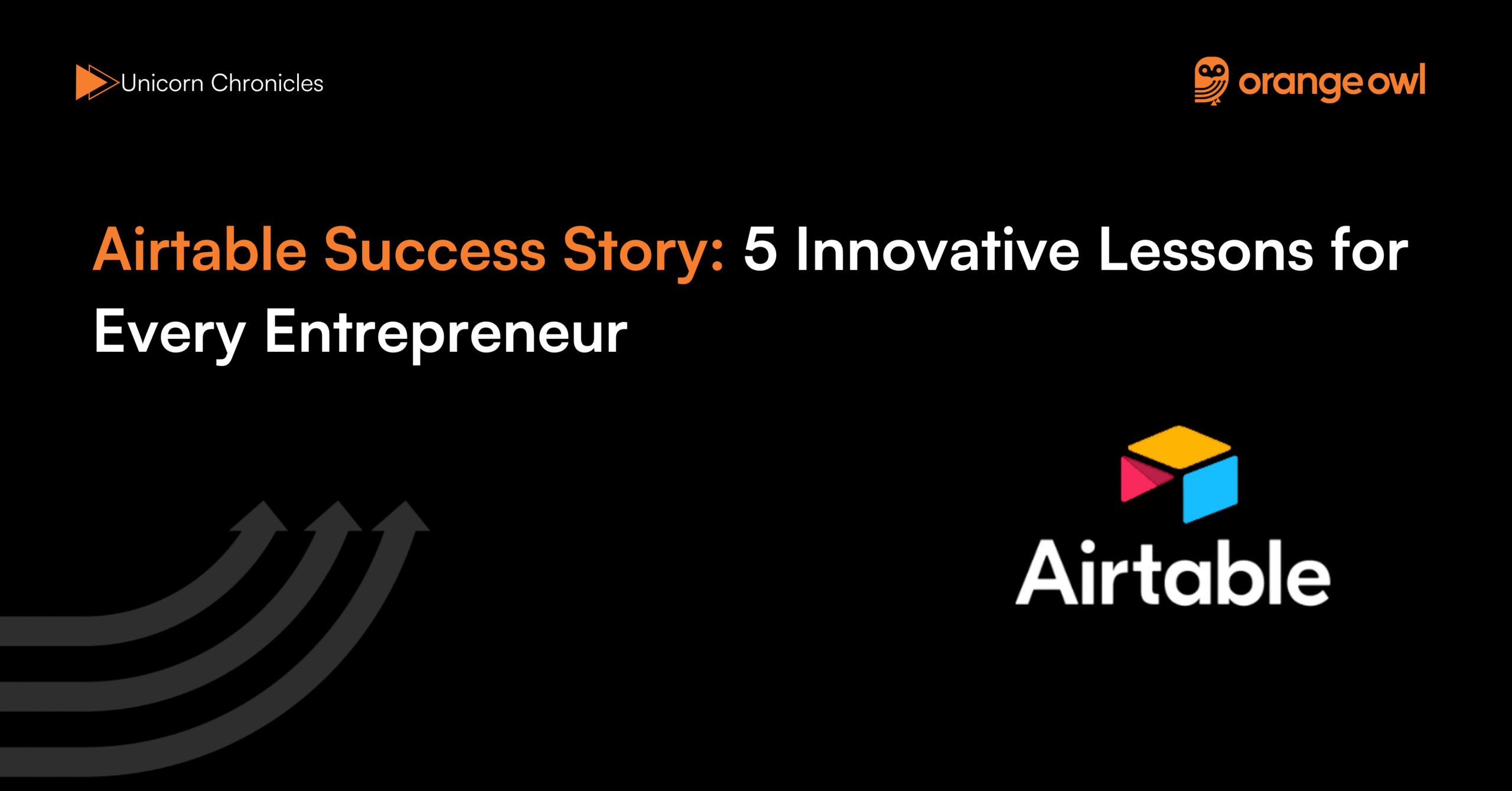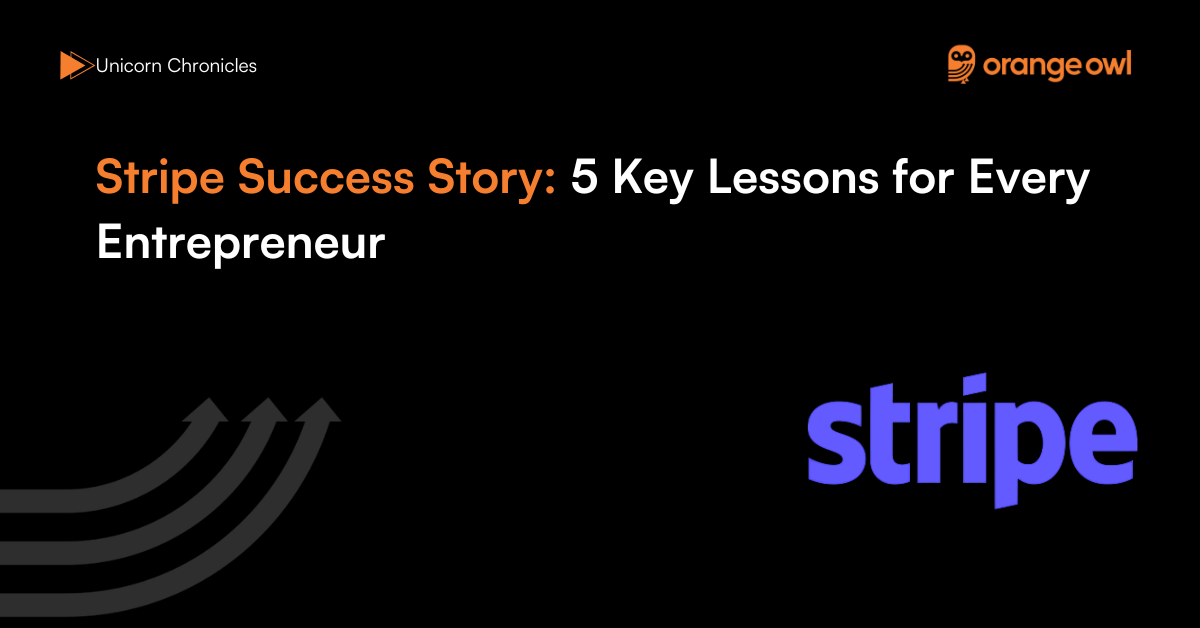Airtable Success Story: 5 Innovative Lessons for Every Entrepreneur
Orange Owl
August 21, 2025

Table of Contents
Introduction
In 2013, Howie Liu set out to transform how teams and enterprises build and manage software. The result was Airtable; a no-code platform designed to blend the familiarity of a spreadsheet with the power of a database. The vision was bold: democratize software creation so that anyone, from small teams to Fortune 500 enterprises, could design the applications they needed without writing a single line of code.
Airtable’s rise has been remarkable. From its humble beginnings as a product-led growth (PLG) darling, the platform has scaled to serve over 500,000 organizations, with 50% of the Fortune 500 counted among its paying customers. The company has raised $1.3 billion in funding and reached a peak valuation of $11.7 billion, while also achieving cash flow positivity in 2024.
As Liu puts it:
“Airtable is a complete app builder; the fastest and easiest to use.”
Origin Story
The seeds of Airtable were sown from Liu’s fascination with human-computer interaction. Back in college, he studied neural networks but quickly realized that the real bottleneck in computing was usability. “The constraint to use software effectively was very UX oriented,” he recalls. His early startup was acquired by Salesforce, but he left with a conviction: software creation should not be reserved for coders.
This conviction led to Airtable. Instead of rigid software tools, Liu envisioned a platform that would let anyone build powerful, custom applications. The company launched with a simple premise spreadsheet meets database but quickly proved to be much more. Early adopters included both prosumers and large enterprises, who used Airtable for workflows ranging from marketing campaigns to retail operations.
As Liu notes:
“If we had designed the perfect platform for AI workflows, it would look like Airtable.”
Beyond its functional appeal, Airtable’s early years highlighted the deep resonance of its mission. Liu and his co-founders positioned the tool not merely as software, but as a creative canvas for knowledge workers. The product gave designers, marketers, and operations managers a sense of empowerment: they could tailor solutions to their exact needs without coding skills. This empowerment narrative set Airtable apart from rigid SaaS platforms and earned it a loyal early community.
Moreover, the early adoption by both prosumers and enterprises validated Airtable’s dual-market approach. Small teams loved the flexibility, while large organizations saw it as a way to speed up processes that were traditionally locked in IT cycles. Liu emphasized that this blend was deliberate, he wanted Airtable to work just as well for a freelancer planning projects as for a Fortune 500 company orchestrating global campaigns.
The company’s culture also grew out of this philosophy of accessibility and creativity. Early Airtable marketing often spotlighted real customers building imaginative workflows from television producers organizing shoots to nonprofits coordinating disaster relief. These stories reinforced the idea that Airtable was not just a tool, but a platform for democratized innovation.
This foundation would later prove critical as Airtable scaled into enterprise markets. The DNA of usability and creativity never left, even as the company layered in security, integrations, and AI capabilities.
Business Landscape and Challenges
When Airtable entered the market, it faced a crowded and evolving landscape. The space was already populated by giants like Salesforce and ServiceNow, as well as lightweight project management tools like Asana and Trello. Airtable’s challenge was twofold: differentiate itself in a noisy market, and prove its value as a serious enterprise platform capable of scaling with the world’s largest organizations.
At first, Airtable grew virally through PLG. This grassroots adoption provided credibility, but scaling beyond enthusiastic teams required building trust with CIOs, passing rigorous security audits, and integrating into enterprise procurement systems. These steps transformed Airtable from a beloved productivity app into a tool enterprises could depend on.
The pandemic further accelerated digital adoption, pushing Airtable deeper into enterprise territory. Customers demanded not only intuitive user experiences but also enterprise-grade scalability, security, and integrations with tools like Salesforce, Snowflake, and SAP. The challenge was steep, but Airtable embraced it. By 2023, Airtable had grown revenues into the hundreds of millions annually, placing it in the top decile of public SaaS growth rates. According to Forbes, Airtable reached $142 million in annual recurring revenue (ARR) by 2021, growing more than 50% year-over-year.
As Liu remarked in an interview:
“Great companies are public capable—whether or not they choose to go public.”
Another major challenge was perception. Many early adopters viewed Airtable as a lightweight tool—a glorified spreadsheet—rather than a robust enterprise solution. Overcoming this skepticism required years of customer success stories, technical investments, and intentional repositioning. Liu emphasized that the team spent significant effort educating the market: Airtable was not just a spreadsheet alternative, but a flexible app platform that could power mission-critical workflows at scale.
Growth Strategies
Airtable’s growth has been anchored in several strategic pivots, each reflecting a deliberate effort to evolve with the needs of its customers:
1. Product-Led Growth (PLG): Airtable began as a viral product loved by individual users. By making the tool highly intuitive, it spread organically within companies—first through marketing or design teams, then across entire organizations. The viral adoption gave Airtable credibility without expensive marketing spend.
2. Enterprise Focus: Around 2020, Airtable shifted gears from being a prosumer tool to winning enterprise clients. This meant strengthening compliance (SOC 2, GDPR), building robust admin tools, and hiring enterprise sales teams. The company began working directly with CIOs and CMOs of Fortune 500 firms, pitching Airtable as a strategic platform rather than a simple collaboration tool.
3. AI Integration: Airtable integrated AI features that turned static workflows into dynamic ones. For example, retailers used AI to translate thousands of SKUs instantly, while marketers automated campaign planning. The focus was on embedding AI into existing workflows rather than creating new layers of complexity.
4. Ecosystem and Connectors: Enterprises rarely use one tool in isolation. Airtable responded by building deep integrations with Snowflake, Salesforce, and AWS Bedrock, ensuring it could serve as a central hub in enterprise workflows. This expanded Airtable’s stickiness and made it harder for companies to churn.
5. Organizational Realignment: To execute its strategy, Airtable restructured into dedicated divisions; AI, enterprise, teams, and solutions. This alignment allowed each unit to focus on scaling its domain while staying connected to the broader company mission.
Together, these strategies helped Airtable grow from a viral favorite into a platform with hundreds of millions in annual revenue, trusted by some of the world’s largest organizations.
Marketing Strategy
Unlike traditional SaaS companies reliant on aggressive advertising, Airtable leaned into storytelling, community building, and customer advocacy. Its viral growth was fueled by end users who loved the product, which later evolved into showcasing enterprise-scale transformations. The company invested heavily in customer education through templates, webinars, and community forums making it easier for users to discover and share use cases.
Airtable also positioned itself as more than just a tool: it became a brand associated with creativity and empowerment. Campaigns often highlighted how diverse organizations from small nonprofits to global media companies used Airtable to innovate. This approach helped prospective customers imagine their own possibilities with the product. Instead of leading with features, Airtable led with stories of transformation and impact.
Another pillar of its marketing was the focus on community and ecosystems. Airtable cultivated an active online community where users exchanged templates and workflow ideas. This not only drove organic adoption but also created a sense of belonging that competitors struggled to replicate. By enabling user-generated content and solutions, Airtable amplified its reach without massive ad spend.
The company’s enterprise marketing strategy later expanded to emphasize strategic case studies. Examples included AWS using Airtable for marketing operations, Netflix leveraging it for content planning, and large retailers managing supply chains. These stories demonstrated Airtable’s credibility as a mission-critical platform, countering early perceptions of it being just a lightweight spreadsheet alternative.
Finally, Airtable embraced thought leadership by tying its platform to broader industry shifts like AI and no-code. By framing itself as a pioneer in these movements, Airtable captured mindshare among executives and developers alike.
As Liu noted:
“AI isn’t about replacing workflows—it’s about enhancing them.”
5 Innovative Lessons for Every Entrepreneur
1. Lead with Vision, Ground with Discipline
Liu consistently balanced long-term vision with short-term execution. His conviction that “software creation should not be reserved for coders” became Airtable’s north star. At the same time, he emphasized rigorous discipline in hiring, product prioritization, and enterprise sales execution. Entrepreneurs can learn the art of holding a bold vision while anchoring decisions in measurable progress.
2. Adaptability in Leadership
Liu has described entrepreneurship as a constant process of reinvention: “It’s always a new job. Every phase requires you to learn differently.” This flexibility—shifting from founder-builder to enterprise CEO—was critical in Airtable’s growth. Entrepreneurs should cultivate the humility and openness to evolve their leadership style as their company scales.

3. Empower Teams through Culture
Airtable’s early culture celebrated creativity, accessibility, and empowerment. Liu fostered an environment where employees and users alike could “build their own solutions.” This management approach—trusting teams to innovate—allowed Airtable to move quickly while maintaining cohesion. A strong culture of empowerment is one of the most scalable management tools
4. Strategic Patience and Timing
While many startups rush into enterprise markets, Liu paced Airtable’s entry. He waited until the product had grassroots adoption and credibility before investing heavily in CIO-level conversations. This patience ensured Airtable was ready to meet enterprise demands. Leaders should learn to time pivots thoughtfully, aligning with readiness and market demand.
5. Communicate a Narrative, Not Just a Product
Liu understood that leadership also means storytelling. By consistently positioning Airtable as a platform for creativity and democratization, he rallied employees, customers, and investors around a shared mission. Entrepreneurs should remember that their role is not just to manage operations, but to craft and communicate a compelling narrative.
Conclusion
Airtable’s journey from a scrappy PLG startup to a profitable enterprise SaaS leader showcases how bold vision, thoughtful pivots, and user-first design can create lasting impact. Its story highlights the importance of democratizing technology, embedding usability as a strategic weapon, and thoughtfully embracing AI.
Liu’s reflections offer a reminder for entrepreneurs:
“It’s always a new job. Every phase requires you to learn differently.”
What sets Airtable apart is not just its product, but its adaptability—moving from prosumer darling to enterprise powerhouse, while staying true to its mission. The company illustrates how startups can transition through multiple growth phases, adapt their strategies, and continue to deliver value at scale.
The broader takeaway is that success in modern SaaS requires mastering dualities: PLG and enterprise, usability and scalability, AI innovation and practicality. Airtable’s trajectory proves that startups that embrace these dualities can not only grow rapidly but also endure for the long term.
For entrepreneurs, the key message is clear: the future belongs to builders who combine vision with execution, democratization with enterprise discipline, and innovation with usability. Airtable’s story is not just about software—it’s a roadmap for sustainable, adaptable growth.


